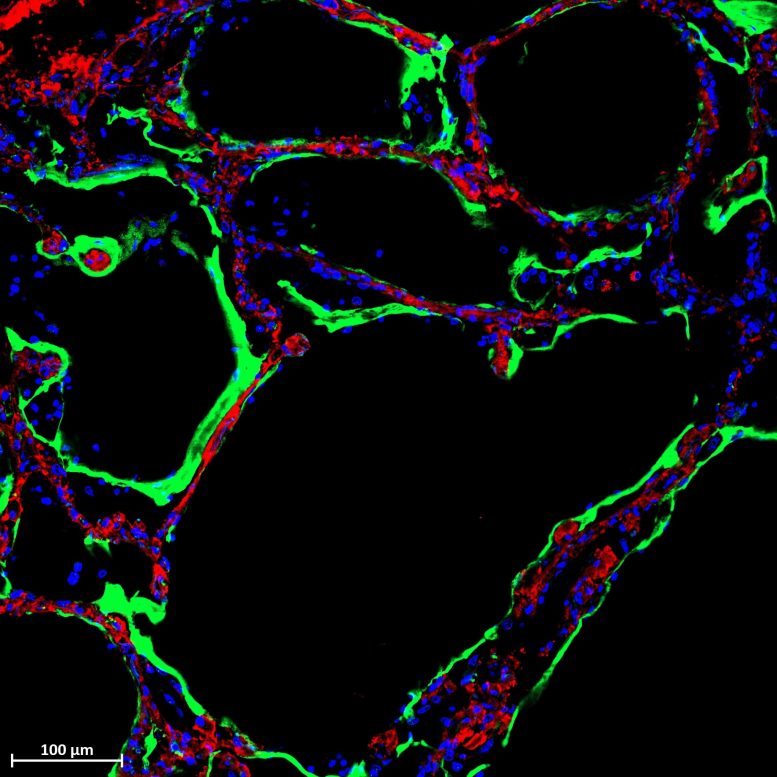
Immunofluorescent staining shows expression of the new SARS-CoV-2 Spike-receptor LRRC15 (green) in post-mortem lung tissue section from individual with COVID-19. Credit: The University of Sydney
The protein receptor found in the lungs sticks to the virus and pulls it away from the target cells.
University of Sydney scientists have discovered a protein in the lung that blocks SARS-CoV-2 infection and forms a natural protective barrier in the human body.
This protein, the leucine-rich repeat-containing protein 15 (LRRC15), is an inbuilt receptor that binds the SARS-CoV-2 virus without passing on the infection.
The research opens up an entirely new area of immunology research around LRRC15 and offers a promising pathway to develop new drugs to prevent viral infection from coronaviruses like COVID-19 or deal with fibrosis in the lungs.
The study was published on February 9, 2023, in the journal PLOS Biology. It was led by Professor Greg Neely with his team members Dr. Lipin Loo, a postdoctoral researcher, and PhD student Matthew Waller at the Charles Perkins Centre and the School of Life and Environmental Sciences.
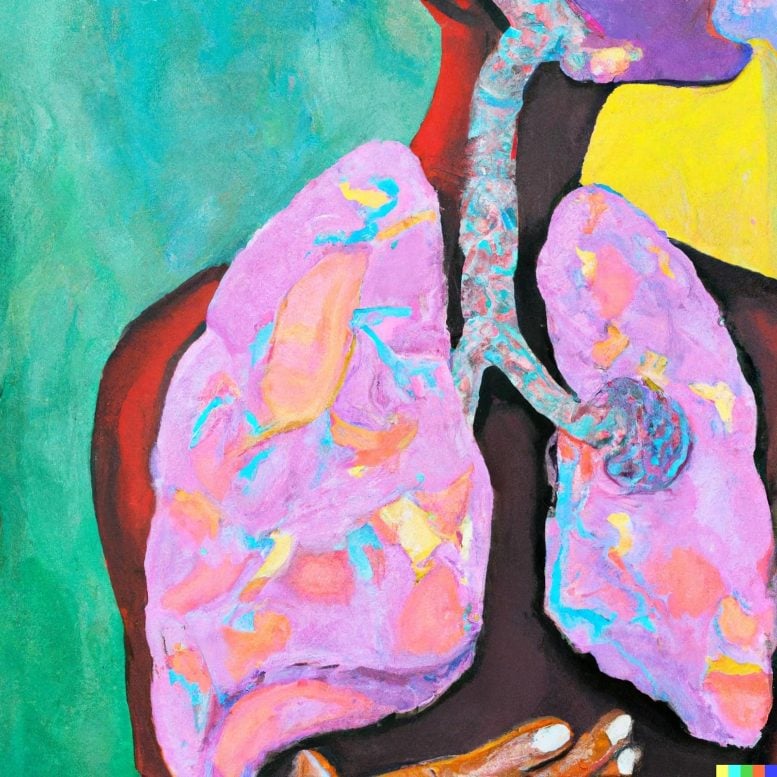
Pastel pop art illustration of human lung generated using OpenAI’s DALL·E 2. Instructions used to generate this image were “a pastel pop art painting of the human anatomy with the lungs colorful and bright.” Credit: OpenAI’s DALL·E 2/Greg Neely
The University study is one of three independent papers that reveal this specific protein’s interaction with COVID-19.
“Alongside two other groups, one at Oxford, the other at Brown and Yale in the USA, we found a new receptor in the LRRC15 protein that can stop SARS-CoV-2. We found that this new receptor acts by binding to the virus and sequestering it which reduces infection,” Professor Neely said.
“For me, as an immunologist, the fact that there’s this natural immune receptor that we didn’t know about, that’s lining our lungs and blocks and controls virus, that’s crazy interesting.
“We can now use this new receptor to design broad-acting drugs that can block viral infection or even suppress lung fibrosis.”
What is LRRC15?
The COVID-19 virus infects humans by using a spike protein to attach to a specific receptor in our cells. It primarily uses a protein called the angiotensin-converting enzyme 2 (ACE2) receptor to enter human cells. Lung cells have high levels of ACE2 receptors, which is why the COVID-19 virus often causes severe problems in this organ of infected people.
Like ACE2, LRRC15 is a receptor for coronavirus, meaning the virus can bind to it. But unlike ACE2, LRRC15 does not support infection. It can, however, stick to the virus and immobilize it. In the process, it prevents other vulnerable cells from becoming infected.
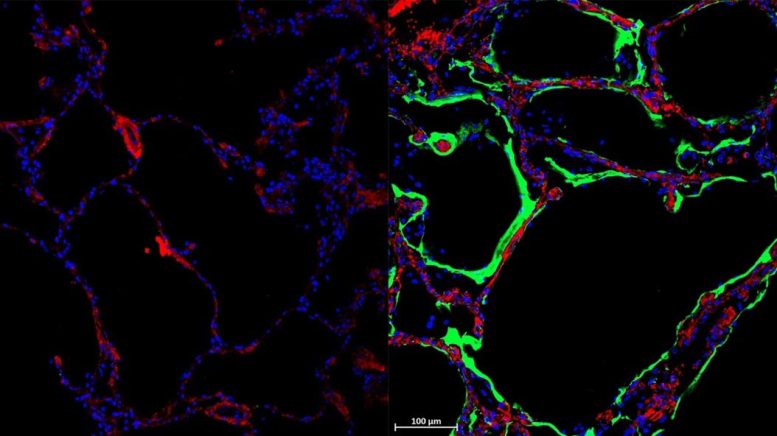
Immunofluorescent staining shows expression of the new SARS-CoV-2 Spike-receptor LRRC15 (green) in post-mortem lung tissue section from an individual with COVID-19. Credit: The University of Sydney
“We think it acts a bit like Velcro, molecular Velcro, in that it sticks to the spike of the virus and then pulls it away from the target cell types,” Dr. Loo said.
“Basically, the virus is coated in the other part of the Velcro, and while it’s trying to get to the main receptor, it can get caught up in this mesh of LRRC15,” Mr. Waller said.
LRRC15 is present in many locations such as lungs, skin, tongue, fibroblasts, placenta and lymph nodes. But the researchers found human lungs light up with LRRC15 after infection.
“When we stain the lungs of healthy tissue, we don’t see much of LRRC15, but then in COVID-19 lungs, we see much more of the protein,” Dr. Loo said.
“We think this newly identified protein could be part of our body’s natural response to combating the infection creating a barrier that physically separates the virus from our lung cells most sensitive to COVID-19.”
Implications of the research
“When we studied how this new receptor works, we found that this receptor also controls antiviral responses, as well as fibrosis, and could link COVID-19 infection with lung fibrosis that occurs during long COVID,” Mr. Waller said.
“Since this receptor can block COVID-19 infection, and at the same time activate our body’s anti-virus response, and suppress our body’s fibrosis response, this is a really important new gene,” Professor Neely said.
“This finding can help us develop new antiviral and antifibrotic medicines to help treat pathogenic coronaviruses, and possibly other viruses or other situations where lung fibrosis occurs.
“For fibrosis, there are no good drugs: for example, idiopathic pulmonary fibrosis is currently untreatable.”
Fibrosis is a condition in which lung tissue becomes scarred and thickened, causing breathing difficulties. COVID-19 can cause inflammation and damage to the lungs, leading to fibrosis.
The authors said they are developing two strategies against COVID-19 using LRRC15 that could work across multiple variants – one which targets the nose as a preventative treatment, and another aimed at the lungs for serious cases.
The researchers also said that the presence or lack of LRRC15, which is involved in lung repair, is an important indication of how severe a COVID-19 infection might become.
“A group at Imperial College London independently found that absence of LRRC15 in the blood is associated with more severe COVID, which supports what we think is happening.” Dr. Loo said. “If you have less of this protein, you likely have serious COVID. If you have more of it, your COVID is less severe.
“We are now trying to understand exactly why this is the case.”
The research involved screening human cell cultures for genes and investigating the lungs of human COVID-19 patients.
Reference: “Fibroblast-expressed LRRC15 is a receptor for SARS-CoV-2 spike and controls antiviral and antifibrotic transcriptional programs” by Lipin Loo, Matthew A. Waller, Cesar L. Moreno, Alexander J. Cole, Alberto Ospina Stella, Oltin-Tiberiu Pop, Ann-Kristin Jochum, Omar Hasan Ali, Christopher E. Denes, Zina Hamoudi, Felicity Chung, Anupriya Aggarwal, Jason K. K. Low, Karishma Patel, Rezwan Siddiquee, Taeyoung Kang, Suresh Mathivanan, Joel P. Mackay, Wolfram Jochum, Lukas Flatz, Daniel Hesselson, Stuart Turville and G. Gregory Neely, 8 February 2023, PLOS Biology.
DOI: 10.1371/journal.pbio.3001967
Funding: National Health and Medical Research Council, New South Wales Government, Australian Government

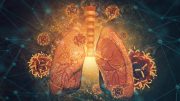
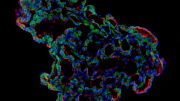

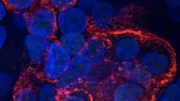
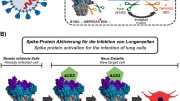


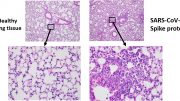
This is excellent news! Not only for fighting Coivd but I had a friend who died of IPF a couple of years back.
AI generated pictures, making human graphic artists extinct one ugly as lifeless painting at a time.